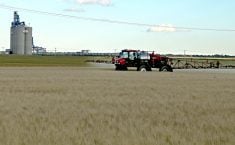Western Canadian pork producer organizations want to meet with major packers to discuss pricing improvements.
In a letter addressed to Maple Leaf Foods, Olymel and Donald’s Fine Foods, the producer organizations in each of the four western provinces said they wanted to explore a pricing model that incorporates cut-out value, rather than the current mechanism based on U.S. data.
“The pricing mechanism in the U.S. that we were using in Canada is based on a very small number of pigs and it’s not providing the right market signals to encourage production here in Western Canada,” said Andrew Dickson, general manager of the Manitoba Pork Council.
Read Also

House ag committee to undertake several studies
The House of Commons standing agriculture committee has set its agenda for the coming months. Members began the fall sitting with a two-hour update on international trade
“What we’re saying is, let’s have an initial meeting. Let’s have a share of views. We don’t have to make any final decisions…. Let’s talk about it. What do we want to do here, guys?”
The four pork organizations said price spreads between provinces can vary by more than $100 per pig. Market pressures caused by the pandemic have depressed U.S. Department of Agriculture live pig prices, on which Canadian prices are set.
Discontent with the pricing system even before the pandemic led Quebec producers to establish a new mechanism with processors that incorporates the carcass or cut-out value into the payment. HyLife Foods in Manitoba has developed a similar model that incorporates cut-out value.
“In our mind, somehow connecting (hog prices) to the cut-out, the value of the carcass, the value of the pig, is something we need to do, and both have to make a profit. Both the producer and the processor, we both need to be in a positive frame to move forward,” said Alberta Pork executive director Darcy Fitzgerald.
There is domestic and global demand for pork but Canada’s hog processing plants are not running at capacity, he added.
Producer returns on market hogs are low and in Alberta some Hutterite colonies, which historically have been major hog producers, are leaving the industry.
“In Western Canada, there’s a potential for two million more pigs really, if we just got our act together,” Fitzgerald said.
“And it would help those packing plants because they’re not at capacity. They need more pigs but they’re not signalling to the producer a way to get more pigs. They’re actually driving the producer out of business and they’re losing pigs. Somehow we need to fix our business model.”
The need to improve producers’ situation has become more pressing with trade uncertainty between the U.S. and China, traditionally a major buyer of North American pork. With the Canadian price dependent on U.S. markets, any trade disruption between those two countries would affect Canadian prices as well.
“We’re looking at a number of options and we’re going to see what the processors come up with as well,” said Dickson about the anticipated meeting.
Dickson noted producers need better returns and greater assurance on pricing if they are to replace aging hog production infrastructure on many of their farms. Most barns were built in the 1990s with an anticipated 30-year life span. Many have been renovated, but new facilities are eventually needed to incorporate the latest technology and production efficiencies.
Newer facilities with updated systems can benefit the environment, food safety, animal welfare and biosecurity, the letter said. Sustainability is also key.
“I think a base price is what the producers here are looking for,” said Fitzgerald.
“For us, really, it’s come to that point where we’re looking at this saying, if you were in a business that has a high demand for the product and you can’t even maintain the marketplace you have today, let alone any growth, there’s definitely market signals that say there’s a problem here and we need to fix that.”
Producers can use various government risk management programs but Fitzgerald said that, except for emergencies, it shouldn’t be necessary if the system adequately rewards producers and packers.
“We can’t keep going back to government and taxpayers to keep the industry afloat. That’s not fair. It’s not fair to taxpayers and it’s not fair to the producers either, and it’s a disservice to our packers as well, to say that we’re not working together to operate this business like a business.”
In the letter to the three packers, the four hog producer organizations noted the “antagonistic relationship” between the two factions that weakens the industry and the Canadian pork brand in the global marketplace.
They asked for a reply by June 30 from the three packers regarding the proposed meeting.

















